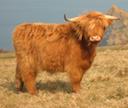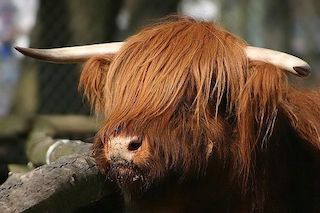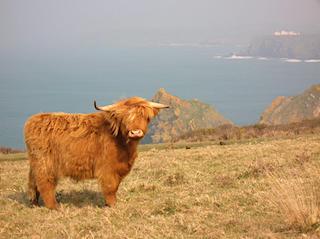 The hardiness of this distinctive breed makes it an excellent choice for conservation grazing.
The hardiness of this distinctive breed makes it an excellent choice for conservation grazing.
Photo: Steve Townsend
Scientific name: Bos taurus is the scientific name for domesticated cattle.
Other common names: In Scottish Gaelic they are called Bò Ghàidhealach, or Heilan coo in Scots.
Cornish name: Bugh is the word for a cow; tarow is the word for a bull; gwarthek is the collective noun for horned cattle.
What to look for:
- Appearance and colouring: Shaggy haired, horned cattle, with coat colouring including reddish, black and dun, as well as brindle or paler varieties.
- Size: Bulls are up to 120 cm high and 800 kg in weight; cows are up to 106 cm and 500 kg.
- Where: Scotland is the origin but, as well as being found all over the UK, the breed has been exported to many countries of the world from the nineteenth century onwards, notably to Australia, Canada and Scandinavia.
 Of all the animals used for conservation grazing, Highland Cattle possibly look the most imposing, even a little scary, with their horns and wild shaggy coats. In fact, this is a fairly docile breed, though when the cows have calves they are as protective of them as other breeds of cattle you will find on The Lizard. If you come across cattle on The Lizard, especially in the spring when they have calves with them, remember to keep a respectable distance, with dogs on a short lead.
Of all the animals used for conservation grazing, Highland Cattle possibly look the most imposing, even a little scary, with their horns and wild shaggy coats. In fact, this is a fairly docile breed, though when the cows have calves they are as protective of them as other breeds of cattle you will find on The Lizard. If you come across cattle on The Lizard, especially in the spring when they have calves with them, remember to keep a respectable distance, with dogs on a short lead.
The breed’s origins go back hundreds of years in the Highlands and Islands of Scotland, with the first documented reference dating to the sixth century AD. Their ancestors arrived, though, some time before that, brought to Scotland in the company of Neolithic farmers. Originally kept to provide milk and meat on small family farms in the Highlands, their shaggy coat is an adaptation to the cold, wet and windy climate of the north, and has two layers: soft downy hair close to the skin, providing warmth, covered by an outer shaggy oily coat, which protects against the driving rain and freezing winter conditions of their mountainous home. These characteristics prove useful on the exposed plateau and cliff tops of The Lizard, too.
 Conservation grazing is the use of domesticated or semi-domesticated animals to graze in some habitats, keeping down the more vigorous vegetation and scrub and therefore allowingrarer, more delicate plants to gain a foothold. Grazing also benefits animal and bird species, such as the Chough, which forages in short, cropped vegetation close to cliff tops.
Conservation grazing is the use of domesticated or semi-domesticated animals to graze in some habitats, keeping down the more vigorous vegetation and scrub and therefore allowingrarer, more delicate plants to gain a foothold. Grazing also benefits animal and bird species, such as the Chough, which forages in short, cropped vegetation close to cliff tops.
Did you know…?
…The Highland Cattle registry is the oldest herd book in the world.
…In the snowy conditions of winter, Highland Cattle use their horns to sweep away the snow in order to uncover vegetation to eat.
Published: October 2017
Author: Amanda Scott
Photos: Upper: Petra Karstedt, CC BY-SA 2.0; lower: Highland Cow on Mullion Cliffs, Steve Townsend
